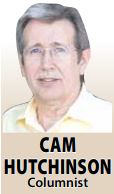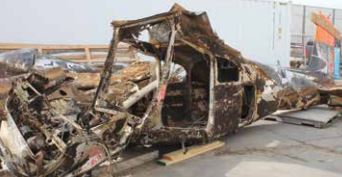
Don Miller promised Maurice Gran he wouldn’t rest easy until the plane, in which Gran’s younger brother died, was found.
True to his word, Miller initiated the successful search that led to discovering the Cessna 180 that crashed into Peter Pond Lake on Aug. 20, 1959. On board were pilot Ray Gran and Harold Thompson, a conservation officer.
The weather can turn bad quickly in the North, and Gran was caught in a thick fog with no way out. The two men were flying north from Buffalo Narrows to La Loche. Some people believe they took to the sky that day to nab a poacher.
In July 2017, Miller had lunch with Drs. Linda Rae Kapusta and her husband Don, who were visiting from Toronto. Linda Rae never got to meet her father. Her mother, Marcella Gran, was pregnant with Linda Rae when the plane crashed.
The Grans were family friends of the Millers, with some of Ray Gran’s relatives living just down the street in Meadow Lake. Miller’s mother and Marcella Gran were best friends.

that went missing in 1959. (Photo by Cam Hutchinson)
Their friendship led to Miller having lunch with the Kapustas. “I had laid out a scenario for them about how they could possibly find the aircraft, but it was going to take state-of-the-art sonar equipment, something that was not available in Saskatchewan,” Miller said in a conversation at the Saskatchewan Aviation Museum and Learning Centre.
He said those who previously searched for the plane used a rope and grappling hook. “Based on how the plane was sitting upside down, the chance of even snagging one of those pontoons would have been pretty tough.”
Soon after the lunch meeting, Dr. Don Kapusta returned to Toronto and started making a plan to attempt to find the aircraft. That plan would include sonar equipment, as Miller had suggested.
“Dr. Kapusta contacted a group of experts in Boston who had been involved in looking (and finding) the Avro Arrow aircraft remains in Lake Ontario,” said Miller, who is 72.
The Avro Arrow was a scale model of a supersonic interceptor that was being developed to keep Russian bombers at bay. This was during the Cold War.
In July 2018, the search for the Cessna 180 officially began with Kapusta, a relative, and two sonar experts scanning the lake. They divided the lake into quadrants. No. 1 was their target.
“It was right around supper time on July 31 that they found the aircraft.” It was in quadrant No. 1. They found it on the first day of the search. Kapusta texted Miller with the good news. “We have two families that have been provided with closure and it has also provided closure for the people living in the area. It was always on their minds as well,” Miller said.
A man from the area was the last person to hear the sound of the propeller. Standing on a shore of Peter Pond Lake, he heard the plane circling before the sound of the plane hitting the water. He is now 93 years old.
“The great people of Michel Village and Dillon, and others living in the northern part of the province provided untold hours of assistance and generosity,” Miller said. “They were feeding the crew out on the lake and helping with everything they possibly could. They were directly involved in getting the aircraft out of the water. “It was a very emotional experience for the people working on the crew.”
It was emotional experience for Miller who had met Ray Gran. “Even though was 12 years old, I remember Raymond and his moustache. He was someone who was living not that far away from us and all of a sudden he is gone. But it was probably more emotional for me knowing I helped.” Once the aircraft was located, the next step was searching for remains and personal items. A dive in September 2018 was called off. “That lake is over 400 square miles of open water,” Miller said. “Even a slight breeze you are going to wind up with five- and six-feet waves. To hold any kind of boat 58 or 60 feet above the wreckage in a still position and do almost anything with divers down below is going to be almost an impossibility.”
It was decided that it would be best to try in the winter. In January, divers brought up human remains and some personal belongings. A couple of months later, the plane was pulled from the icy water. Resting on one of the wings was Ray Gran’s wedding ring. Linda Rae Kapusta now wears it on a chain. Marcella Gran died about 12 hours after the plane was found. Rather than tell her immediately, it was decided to wait until the next morning. She died in her sleep that night.
It was in 2006 when Miller promised Maurice Gran, a pilot himself, that he would continue to help locate the plane.
“Maurice told me where he thought the plane was. Looking at the location on the map of the lake, that plane was found so close to where he said it was that it still boggles my mind.” Maurice Gran died in 2007. It has been 60 years since Ray Gran and Harold Thompson died. Now there is closure for the families. “I feel proud of what I was able to do; I’m just one small piece in the puzzle,” Miller said.
“I like to think I maybe lit the fuse and got it rolling, but others picked the baton up and ran with it.”

Aviation Museum and Learning Centre in Saskatoon. (Photo
by Cam Hutchinson)
The wreckage of the plane can be seen at the Saskatchewan Aviation Museum and Learning Centre in Saskatoon. For more information, visit https://saskaviation.ca/.
-Cam Hutchinson
